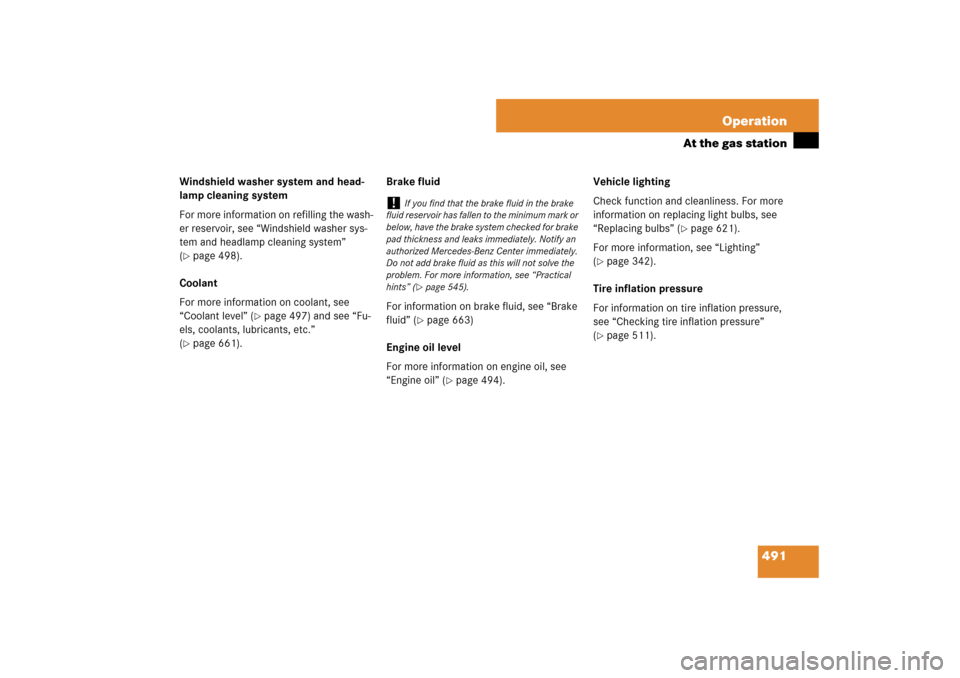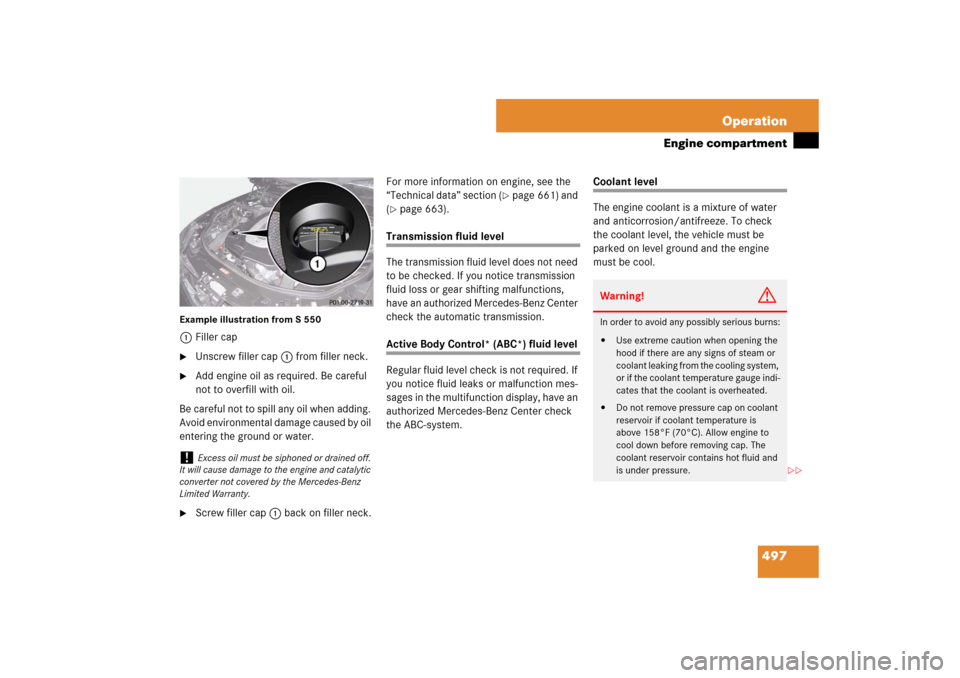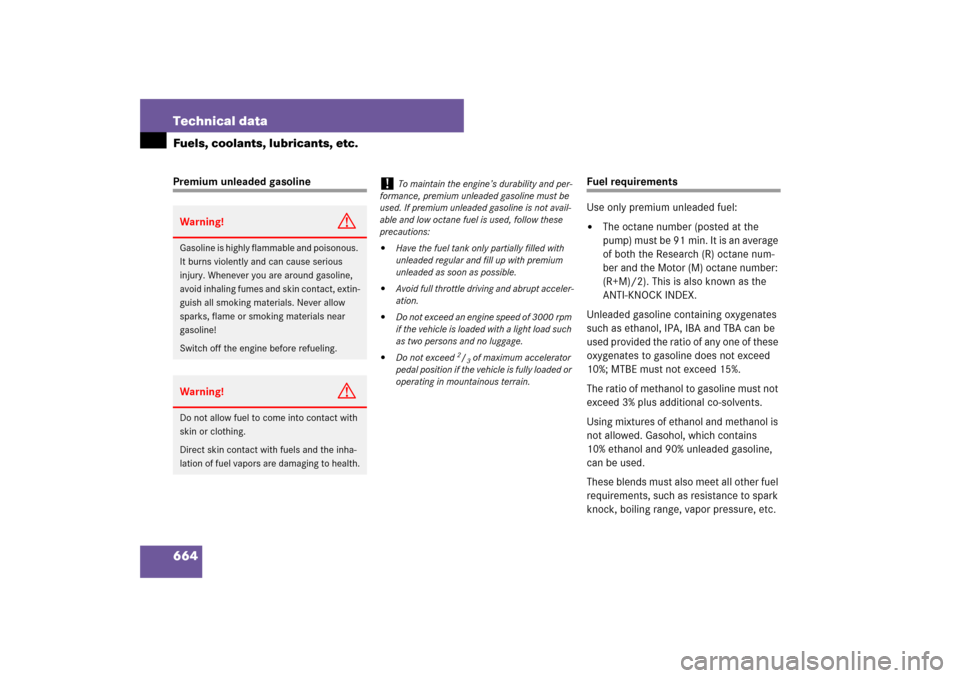Page 254 of 705

253 Control systems
Instrument cluster control system
Switching on the Dynamic Rear View
Monitor* automatically�
Press ( or & to select the
“Assistance” menu.
�
Press % or $ to select the
“Rearview camera” function.
�
Press #.
�
Press # again if you would like to
change the current status.The following settings are available:
Service menu
The “Service” menu is used for �
calling up messages
�
checking tire inflation pressure elec-
tronically with the Advanced TPMS*
(standard on U.S. vehicles)
�
activating Run Flat Indicator
(Canada only)
�
calling up the maintenance service in-
dicator display
�
check engine oil level*Calling up vehicle malfunction, warning
and system status messages stored in
memory
Use the vehicle status message memory
menu to scan malfunction and warning
messages that may be stored in the sys-
tem. Such messages appear in the multi-
function display and are based on
conditions or system status the vehicle’s
system has recorded.
The vehicle status message memory menu
only appears if there are any messages
stored.
i
The image from the Dynamic Rear View
Monitor is shown on the COMAND display.
“On when in
Reverse”
The Dynamic Rear View
Monitor automatically
switches on when reverse
gear is engaged.
“OFF”
The Dynamic Rear View
Monitor is not switched on.
i
The menu overview can be found on
(
�page 243).
Warning!
G
Malfunction and warning messages are only
indicated for certain systems and are inten-
tionally not very detailed. The malfunction
and warning messages are simply a remind-
er with respect to the operation of certain
systems and do not replace the owner’s
and/or driver’s responsibility to maintain
the vehicle’s operating safety by having all
required maintenance and safety checks
��
Page 492 of 705

491 Operation
At the gas station
Windshield washer system and head-
lamp cleaning system
For more information on refilling the wash-
er reservoir, see “Windshield washer sys-
tem and headlamp cleaning system”
(�page 498).
Coolant
For more information on coolant, see
“Coolant level” (
�page 497) and see “Fu-
els, coolants, lubricants, etc.”
(
�page 661).Brake fluid
For information on brake fluid, see “Brake
fluid” (
�page 663)
Engine oil level
For more information on engine oil, see
“Engine oil” (
�page 494).Vehicle lighting
Check function and cleanliness. For more
information on replacing light bulbs, see
“Replacing bulbs” (
�page 621).
For more information, see “Lighting”
(
�page 342).
Tire inflation pressure
For information on tire inflation pressure,
see “Checking tire inflation pressure”
(�page 511).
!
If you find that the brake fluid in the brake
fluid reservoir has fallen to the minimum mark or
below, have the brake system checked for brake
pad thickness and leaks immediately. Notify an
authorized Mercedes-Benz Center immediately.
Do not add brake fluid as this will not solve the
problem. For more information, see “Practical
hints” (�page 545).
Page 498 of 705

497 Operation
Engine compartment
Example illustration from S 5501Filler cap�
Unscrew filler cap1 from filler neck.
�
Add engine oil as required. Be careful
not to overfill with oil.
Be careful not to spill any oil when adding.
Avoid environmental damage caused by oil
entering the ground or water.
�
Screw filler cap1 back on filler neck.For more information on engine, see the
“Technical data” section (
�page 661) and
(
�page 663).
Transmission fluid level
The transmission fluid level does not need
to be checked. If you notice transmission
fluid loss or gear shifting malfunctions,
have an authorized Mercedes-Benz Center
check the automatic transmission.Active Body Control* (ABC*) fluid level
Regular fluid level check is not required. If
you notice fluid leaks or malfunction mes-
sages in the multifunction display, have an
authorized Mercedes-Benz Center check
the ABC-system.
Coolant level
The engine coolant is a mixture of water
and anticorrosion/antifreeze. To check
the coolant level, the vehicle must be
parked on level ground and the engine
must be cool.
!
Excess oil must be siphoned or drained off.
It will cause damage to the engine and catalytic
converter not covered by the Mercedes-Benz
Limited Warranty.
Warning!
G
In order to avoid any possibly serious burns:�
Use extreme caution when opening the
hood if there are any signs of steam or
coolant leaking from the cooling system,
or if the coolant temperature gauge indi-
cates that the coolant is overheated.
�
Do not remove pressure cap on coolant
reservoir if coolant temperature is
above 158°F (70°C). Allow engine to
cool down before removing cap. The
coolant reservoir contains hot fluid and
is under pressure.
��
Page 665 of 705

664 Technical dataFuels, coolants, lubricants, etc.Premium unleaded gasoline
Fuel requirements
Use only premium unleaded fuel:�
The octane number (posted at the
pump) must be 91 min. It is an average
of both the Research (R) octane num-
ber and the Motor (M) octane number:
(R+M)/2). This is also known as the
ANTI-KNOCK INDEX.
Unleaded gasoline containing oxygenates
such as ethanol, IPA, IBA and TBA can be
used provided the ratio of any one of these
oxygenates to gasoline does not exceed
10%; MTBE must not exceed 15%.
The ratio of methanol to gasoline must not
exceed 3% plus additional co-solvents.
Using mixtures of ethanol and methanol is
not allowed. Gasohol, which contains
10% ethanol and 90% unleaded gasoline,
can be used.
These blends must also meet all other fuel
requirements, such as resistance to spark
knock, boiling range, vapor pressure, etc.
Warning!
G
Gasoline is highly flammable and poisonous.
It burns violently and can cause serious
injury. Whenever you are around gasoline,
avoid inhaling fumes and skin contact, extin-
guish all smoking materials. Never allow
sparks, flame or smoking materials near
gasoline!
Switch off the engine before refueling.Warning!
G
Do not allow fuel to come into contact with
skin or clothing.
Direct skin contact with fuels and the inha-
lation of fuel vapors are damaging to health.
!
To maintain the engine’s durability and per-
formance, premium unleaded gasoline must be
used. If premium unleaded gasoline is not avail-
able and low octane fuel is used, follow these
precautions:
�
Have the fuel tank only partially filled with
unleaded regular and fill up with premium
unleaded as soon as possible.
�
Avoid full throttle driving and abrupt acceler-
ation.
�
Do not exceed an engine speed of 3000 rpm
if the vehicle is loaded with a light load such
as two persons and no luggage.
�
Do not exceed
2/3 of maximum accelerator
pedal position if the vehicle is fully loaded or
operating in mountainous terrain.